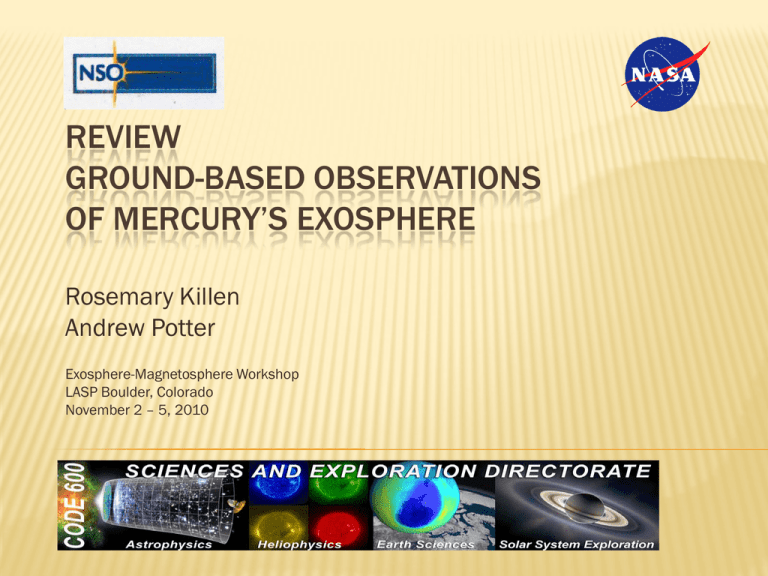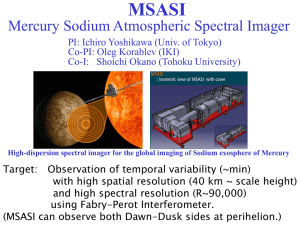REVIEW GROUND-BASED OBSERVATIONS OF MERCURY’S EXOSPHERE Rosemary Killen
advertisement

REVIEW GROUND-BASED OBSERVATIONS OF MERCURY’S EXOSPHERE Rosemary Killen Andrew Potter Exosphere-Magnetosphere Workshop LASP Boulder, Colorado November 2 – 5, 2010 REVIEW OF SPECIES OBSERVED FROM GROUND Sodium (Potter and Morgan, 1985) Potassium (Potter and Morgan, 1986) Calcium (Bida et al., 2000) Aluminum (Bida and Killen, 2010) Iron (Bida and Killen, 2010) Ca+ (Vervack et al., 2010; Bida and Killen, 2010) OBSERVATORIES MacDonald; 2 m Vacuum Tower Telescope, Tenerife; 70 cm THEMIS (French-Italian), Tenerife; 90 cm Steward (60”, 61”, 90”) Haleakala High Altitude Observatory Dunn Solar Telescope, Sunspot, NM (1.1 m) NSO McMath-Pierce (KPNO); 2 m TNG (TELESCOPIO NAIONALE GALILEO); 3.58 m Keck (8 m) Subaru (8.2 m) Major Species: Sodium and Potassium Sodium: Potter & Morgan (1985) MacDonald Potassium: Potter & Morgan (1986) NSO sodium emission at high Doppler shift Potassium emission at high Doppler shift MINOR SPECIES Keck Observations Calcium (Bida et al., 2000; Killen et al., 2005) Fe, Al, Ca+ (Bida and Killen, 2010) THEMIS Al, Fe, Li (upper limits) (Doressoundiram et al., 2009) ESCAPING SPECIES Tail Observations of Na Potter et al., 2002 Mendillo et al. Schmidt et al., 2010 DEFINITIONS Column abundance: Integrated abundance over the line of sight N=Int(n(s)ds) where n(s) is the density (cm-3) s is the line of sight vector TAIL IMAGES Boston University, All Sky Imager, Mendillo et al. At maximum radiation pressure Na can reach 5 million km in 0.1 photoionization lifetime if it escapes at 4 km/sec or 0.3 ionization lifetime if it escapes at 0.1 km/sec 74% of the escaping Na should survive down the tail at maximum RP TAIL IMAGE FROM STEREO (SCHMIDT, DPS, 2010) Unknown source 4.88 million km TAIL AND EXOSPHERE SODIUM POTTER ET AL., 2002 Potter, A.E., et al., The Sodium Tail of Mercury,Met. Planet. Sci., 37, 1165-1172, 2002 Solar radiation pressure is required for tail Radiation pressure of at least 110 cm/sec2 is needed for an appreciable tail (Potter & Killen, 2008) WHATS THE BIG DEAL? • • • • EXTREME VARIABILITY • TEMPORAL • SPATIAL EXTREME TEMPERATURE (REFRACTORIES) EXTREME EXTENT APPARENT LOW ABUNDANCE IN EXOSPHERE OF MAJOR CONSTITUENTS OF REGOLITH (O) SOURCES AND BOUNDARIES PHOTON-STIMULATED DESORPTION UV Radiation Binding Energy at Surface IMPACT VAPORIZATION Micrometeoroids, Meteor Streams, Meteors Velocity Distributions SPUTTERING Solar Wind Bounded by Magnetosphere, IMF REQUIRED VALUES AND UNKNOWNS PSD UV Flux, variability, cross section vs. wavelength Species other than Na, K Impact Vaporization What is the flux of micrometeoroids, meteors Where are the Mercury-crossing meteor streams What fraction of constituents come off as molecules, atoms, ions, direct ejection into excited states Sputtering rates for each species branching ratios variability in solar wind how much plasma impacts the surface and where? sputtering into excited state? sputtering to ions vs. neutrals? ESD yield, flux of electrons ALL – surface composition SPATIAL DISTRIBUTIONS Sodium exhibits high latitude enhancements but not AT the poles Note N/S asymmetry Suggestive of Ion sputtering in open field regions Ion-enhanced sputtering radiation pressure transport Leblanc et al. GRL; observations 2007/06/01 THEMIS a) Na D2 b) Na D1 High Na brightness and column abundances observed in long slit spectra (Sprague et al. 1998) Hokusai (Radar Bright Spot B) Could be Na sources ……………….. Will be thoroughly tested during the orbital phase measurements Debussy (Radar Bright Spot A) data taken at the 61” Mt. Bigelow, echelle spectrograph DAILY VARIATIONS, WEEKLY VARIATIONS Mouawad, N., et al.. Mercury’s sodium exosphere during the first MESSENGER Flyby: Simultaneous Ground-Based and Space Based Observations. Icarus. In press, 2010. Apparent Temperature of Sodium (Killen et al 1999) Analysis of sodium D2emission line profile yielded a temperature in the range 1500 K Dawn Enhancements of Na and K (Hunten & Sprague 2002) Strong morning enhancements of K seen in ground based long slit spectroscopy (Sprague 1992) Also Ca dawn side enhancements (or dusk side depletions?) seen in MESSENGER MASCS data--Are causes the same for Ca and K? -- more data obtained during the orbital phase SODIUM FROM TRANSIT OF MERCURY Observations during the transit of 2003 show North/South enhancements AT the poles and an East/West asymmetry (Schleicher et al., A&A, 425, 2004); data from vacuum telescope on Tenerife POTASSIUM – TEMPORAL VARIATION observed by Potter, Killen and Mouawad, January, 2008 Killen, R.M. et al., Observations of Metallic Species in Mercury’s Exosphere, Icarus 209#1, 2010. SODIUM VS. POTASSIUM DISTRIBUTION Distributions of Sodium and Potassium are different Sodium and Potassium Observed Jan. 17, 2008 Killen, R. M. et al., Observations of Metallic Species in Mercury’s Exosphere, Icarus 209#1, 2010. Ratio of Sodium to Potassium Values range from 30 to 140 RADIATION PRESSURE EFFECTS Planet-wide average sodium emission is plotted against true anomaly angle. Open circles are dawnside, closed circles are duskside. To eliminate the effect of the Doppler shift on solar flux at the rest frequency of atoms in Mercury's exosphere, the emission was normalized to conditions at true anomaly angle 143.78o. The resulting emission values would be proportional to the average column abundance of sodium in the absence of acceleration effects of solar radiation. Potter, A.E., et al., Solar radiation acceleration effects on Mercury sodium emission Icarus 186 #2, 571-580, 2007. Major Species: Sodium and Potassium Sodium: Potter & Morgan (1985) McDonald Potassium: Potter & Morgan (1986) NSO SODIUM VS. RADIATION PRESSURE Uncorrected data: true anomaly < 180 open circles true anomaly > 180 filled circles Potter, A.E., et al. Solar radiation acceleration effects on Mercury sodium emission, Icarus 186 #2, 571-580, 2007. VARIATIONS ABOUT THE ORBIT movie courtesy Matthew Burger: assumes a uniform caldium source for illustration To sun May 2002 CALCIUM June 2005 Calcium radiance (left), velocity (right) Appears to be concentrated anti-sunward Velocity blue shifted – implies high velocity Killen, R.M., et al., The calcium exosphere of Mercury, Icarus, 173#2, 300-311, 2005. OBSERVATIONS OF AL, Fe, Ca+ FROM KECK Bida and Killen, Planetary and Space Science, submitted 2010 4 σ detection Fe 4 σ detection Al 3 σ detection Ca+ WHY ARE GROUND-BASED OBSERVATIONS IMPORTANT? provide a global picture provide a long term baseline pick up many species at once (Keck) high spectral resolution not available from spacecraft provide predictions for spacecraft observations



